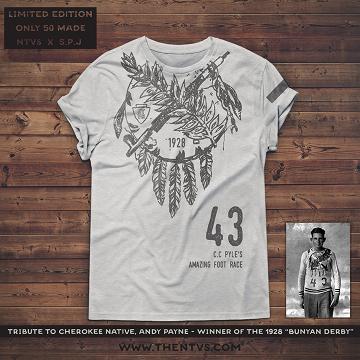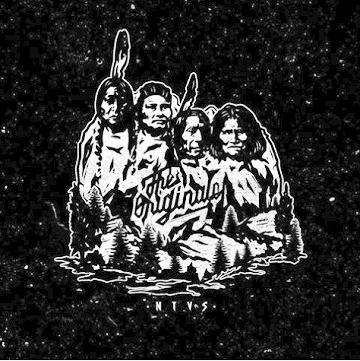"Canku
Ota" is proud to introduce two new designs by the t-shirt company,
The Ntvs
Here's what Aaron, one of the owners, had to say about the creation
and reason for The Ntvs.
"I’m a very artistic person and have always had
a passion for apparel design and clothing brands. Growing up,
I was really into the skate/surf/snow board culture. I would use
the clothes I wore as a way to express myself. As a kid I was
always good at drawing so I decided to go into graphic design
at The Art Institutes International Minnesota. At first we were
just selling a couple t-shirts out of their stand. We soon realized
that our tees were selling out fast! The demand was there so we
kept printing more and more. That is when I realized that we have
something here and I could turn this into a real brand, thentvs.com
was born. I never imagined how fast we would grow."
Jordan, the marketing guru, shared further information about
this young company.
"Our mission is to teach the youth the importance of
embracing culture and history while building a Native Clothing
brand. We do that by crafting Native apparel designs that you
can be proud to wear. Modern Native American clothing and Native
prints that have a deeper meaning.
Maybe it's a light hearted or funny design. Maybe it's a serious
issue that needs to be addressed. We use art and streetwear mixed
with our culture to create one-of-a-kind designs that embrace
our Native American culture and heritage.
The NTVS was created because of our passion in the clothing
and apparel industry. Most of our designs have a story.
Our team is made up of natives from several tribes. We design,
print and ship everything out in house. We are also able to take
custom design orders. We can create custom apparel, logos, websites,
and more."
|
 Clothing
Release Inspired by Andy Payne Clothing
Release Inspired by Andy Payne
Andy Hartley Payne (November 16, 1907 – December
1977) was the winner of the Trans-American
Footrace staged in 1928. Put together by the route 66
Association and sly promoter, Charles Pyle. The race was over
3,000 miles across the country. However, despite how grueling
it was many reporters did not take the competition too seriously
and fondly dubbed it the 'Bunion Race'.
That didn’t dissuade Andy Payne though with a $25,000
cash prize at stake he had an opportunity to save his family
farm and provide for his family. Throughout high school it
was reported Andy Payne practiced by running to school 5 miles
from his family farm.
Payne, a member of the Cherokee
tribe, grew up in Foyil,
Oklahoma which was one of the check point towns along
the route of the race. His father was a friend of Will
Rogers and had worked on the ranch of the latter's family
during his youth.
The footrace was organized to promote U.S.
Route 66 which had recently been built as a simple, well-paved
route across the country, and dubbed "the main street
of America".
When the race started there were over 275 runners but
by the third day over half dropped out. However, Andy Payne
kept pushing forward at a formidable pace. He ran the 3,423.5
mile (5,509.6 km) route from Los Angeles to New York City,
much of it along U.S. Route 66, in 573 hours, 4 minutes, 34
seconds, (23 days) averaging 6 miles per hour over an 84 day
staged run.
Andy Payne was elected clerk to the supreme court in Oklahoma
City, Oklahoma and was reelected 5 times afterwards. {PBS
documentary on the Great American Race of 1928}
He died in December 1977 at the age of 70.
This particular design pays homage to Andy Hartley Payne
who had the courage and perseverance to endure when others
could not.
|

|
 Native
Mount Rushmore Design: Native
Mount Rushmore Design:
Mount Rushmore features 60-foot (18 m) sculptures of the
heads of four United
States presidents: George
Washington (1732–1799), Thomas
Jefferson (1743–1826), Theodore
Roosevelt (1858–1919), and Abraham
Lincoln (1809–1865).[2] The entire memorial covers
1,278.45 acres
Mount Rushmore is controversial among Native
Americans because the United States seized the area from
the Lakota tribe after the Great
Sioux War of 1876. The Treaty
of Fort Laramie from 1868 had previously granted the Black
Hills to the Lakota in perpetuity. Originally known to the
Lakota
Sioux as "The Six Grandfathers",[9] the mountain
was renamed after Charles
E. Rushmore, a prominent New York lawyer, during an expedition
in 1885.
Members of the American
Indian Movement led an occupation
of the monument in 1971, naming it "Mount Crazy Horse".
Among the participants were young activists, grandparents,
children and Lakota holy man John
Fire Lame Deer, who planted a prayer staff atop the mountain.
Lame Deer said the staff formed a symbolic shroud over the
presidents' faces "which shall remain dirty until the
treaties concerning the Black Hills are fulfilled."[47]
In 2004, the first Native American superintendent of the
park, Gerard Baker, was appointed. Baker has stated that he
will open up more "avenues of interpretation", and
that the four presidents are "only one avenue and only
one focus."[48]
The Crazy
Horse Memorial is being constructed elsewhere in the Black
Hills to commemorate the famous Native American leader as
a response to Mount Rushmore. It is intended to be larger
than Mount Rushmore and has the support of Lakota chiefs;
the Crazy Horse Memorial Foundation has rejected offers of
federal funds. However, this memorial is likewise the subject
of controversy, even within the Native American community.
As you might imagine, the Mount Rushmore shirt plays on
the controversy.
|
Find us:
To check out the new shirts, released on 7/30, and the other Ntv
designs visit thentvs.com
|




 Clothing
Release Inspired by Andy Payne
Clothing
Release Inspired by Andy Payne  Native
Mount Rushmore Design:
Native
Mount Rushmore Design: